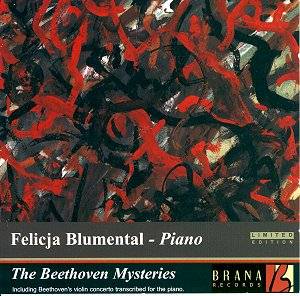One
of the most interesting features of
a great composer’s art is that no matter
how well known it may seem, there is
always more to discover. This is true
in two ways: each performance of a masterpiece
will uncover more of its limitless secrets;
and there are many discoveries of less
well-known pieces to be made.
The
latter contention is the one that operates
here, hence the title: The Beethoven
Discoveries. A bold title, to be
sure, but one that seems justified by
the musical content. The programme is
dominated by well-known music, but presented
in a little known format. In order to
develop his own performing repertoire,
Beethoven made a piano adaptation of
his Violin Concerto, a really bold enterprise
since the violin is a legato instrument
and the piano a percussive instrument.
But if anyone could make it work, Beethoven
could.
In
fact the music has been recorded before
in this version, most notably by Daniel
Barenboim (DG), but the disc under review
is a reissue of a 1967 performance featuring
that fine pianist Felicja Blumental
and is a most welcome addition to the
catalogue. She is well supported by
her conductor, Jiri Waldhans, while
the Brno Philharmonic Orchestra, also
gives a good account of itself, with
impressively tight discipline in tutti
passages.
If
there are doubts they mostly concern
the recorded sound. While this is acceptable
at a bargain price, it does require
some tolerance. As soon as the disc
starts to play, there is a background
sound like a worn LP, and while this
soon becomes less significant, it is
because of the quality of the music
and the performance rather than because
it disappears. Beyond this obvious flaw
some of the sound is over-bright, both
in the piano part and in the strings,
while in the slow movement the woodwind
solos are oddly balanced and ‘larger
than life’.
If
there is a highlight it is probably
Blumental’s stunning performance of
the first movement cadenza, a new version
Beethoven wrote with the addition of
timpani. This makes particularly interesting
listening, especially when it played
with such intensity and gusto as this.
The
other items are early efforts that the
composer may not have intended for survival;
he certainly did not ensure their publication.
It was Beethoven’s pupil Carl Czerny
who ‘rescued’ the Rondo in B flat, rescoring
some of the string textures in the process,
while adding some new high notes to
the piano part, because they became
available on later instruments whose
compass was more extended. The elegance
of this attractive piece makes all these
issues secondary to the enjoyment the
music brings.
The
movement from the D major Piano Concerto
the young Beethoven composed in Bonn
was discovered by Guido Adler in 1888,
then amended by various others. The
suggestion is that this music was written
soon after the young composer’s return
in 1787 from his trip to play to Mozart
in Vienna. However, it is admitted that
the authenticity of the score is not
proven. Be that as it may, it makes
for interesting listening, though anyone
hoping to find an embryonic Emperor
Concerto is likely to be disappointed.
Terry
Barfoot
